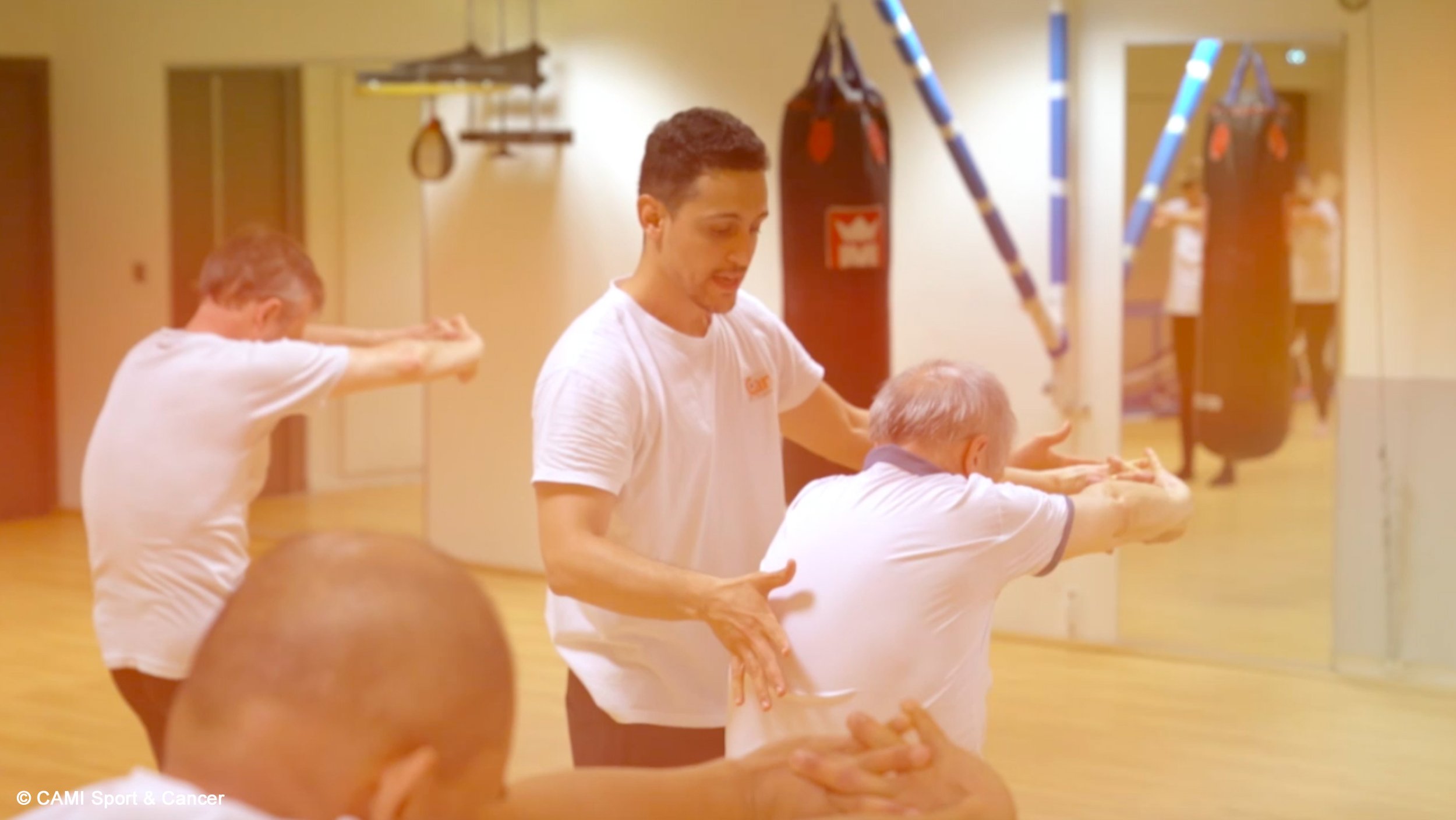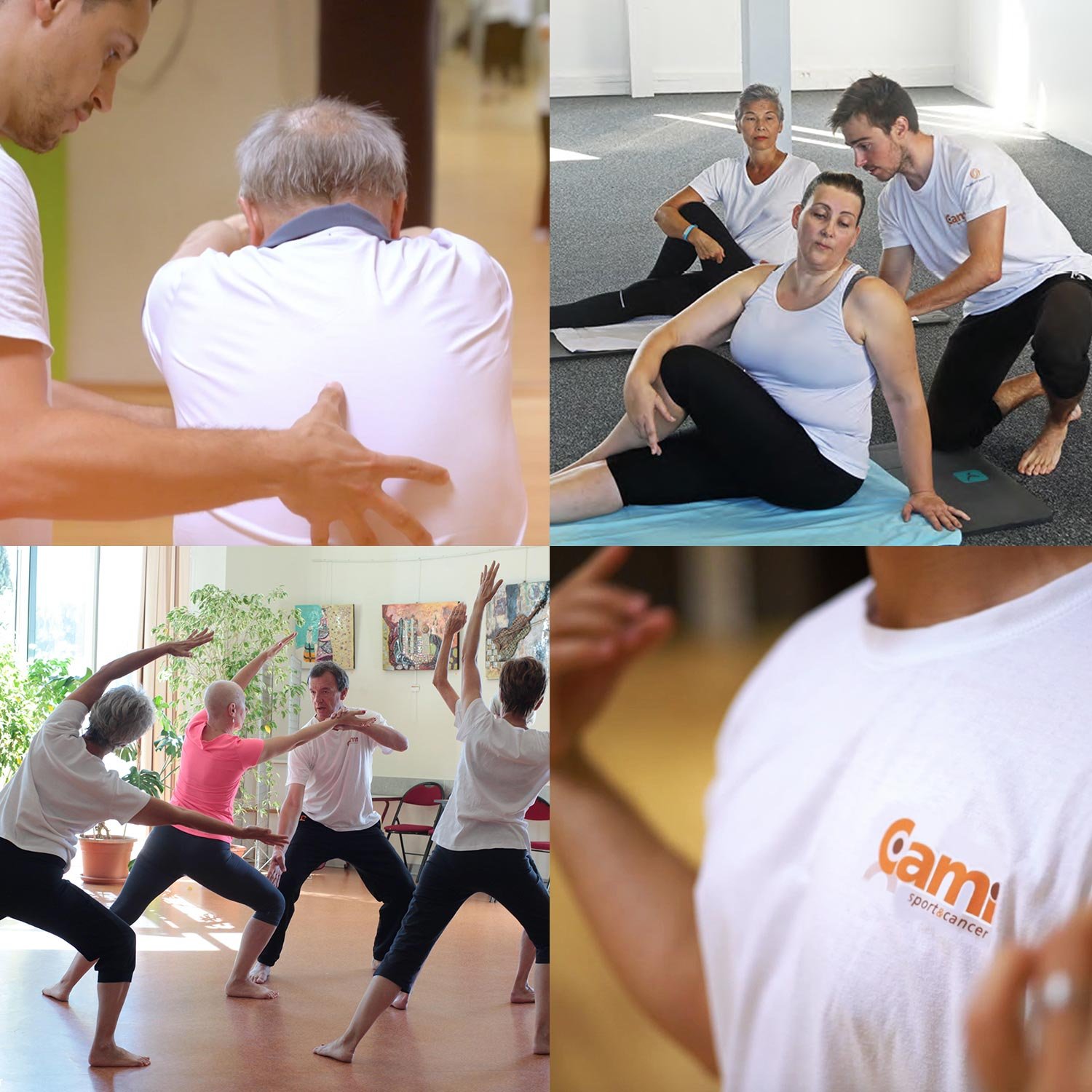2022 Award Laureates
Recognizing innovation and impact
In 2022, the Fit for Life Foundation Awards recognized four organisations for their innovative and impactful approach to improve the health and fitness of older people.

Cami Sport & Cancer (France)
Using sport therapy to fight cancer and improve patients’ lives
Founded in 2000
Active in 80 cities in France
3500 direct beneficiaries per week (2021)
www.sportetcancer.com
Oncologist Thierry Bouillet and former athlete Jean-Marc Descotes created CAMI Sport et Cancer in 2000 with the insight that physical activity improves the wellbeing of cancer patients during treatment, and contributes to better long-term outcomes.
CAMI has designed sport therapy programs for various types of cancer and stages of the disease, from treatment to remission to cure.
CAMI sport therapy aims to reduce the side effects of treatment by restoring balance to the musculoskeletal system, which helps reduce pain and fatigue. It also improves patients’ chances of remission and reduce the risk of relapse.
The programs are delivered by sport therapists who have completed the graduate diploma in Sport & Cancer Therapy developed by CAMI in partnership with the University of Paris.
CAMI has created a 3-stage model of care that can be adapted to each patient's needs, from the start of treatment through to post-cure maintenance.
The care pathway includes:
inpatient programs for people undergoing treatment
outpatient programs for people at the end of treatment or in remission
maintenance programs for cancer survivors
The CAMI method is based on the science of human movement. Its effectiveness is backed by several international studies, which have confirmed that physical activity is linked to an average reduction of the risk of relapse of
49% for colon cancer
43% for breast cancer, and
57% for prostate cancer
It also reduced the risk of death from all types of cancer by 39%.
CAMI currently treats 3,500 patients per week in 80 cities across France, thanks to the expertise of 30 sport therapists.
“The better you feel in your body, the less sick you feel. And the less sick you feel, the more you know you’re on the right path.”

Cycling Without Age (Denmark)
Improving mental wellbeing and building intergenerational relationships by making cycling available to elders with limited mobility
Founded in 2012
Active in 52 countries
575’000 direct beneficiaries (cumulative)
www.cyclingwithoutage.org
Remembering an experience with his disabled father, Ole Kassow started the Cycling Without Age movement in 2012. His aim was to allow elders with limited mobility to get outside and enjoy the fresh air and community around them.
His solution was to build a trishaw and begin offering free rides to residents of local nursing homes. Soon, a group of volunteers signed up to take elders for rides as often as they wanted.
Cycling Without Age grew by launching thriving local chapters, first in Denmark and later in 50 countries around the world, Affiliates operate and fundraise independently, and develop their own culture.
A small core team in Copenhagen provides affiliates with the resources and support they need to get started and grow sustainably. That includes access to trishaws, training for volunteers, a knowledge bank, and a global community of peers.
Affiliates sign a non-exclusive agreement with Cycling Without Age and commit to following the organization’s vision and guiding principles.
Thanks to its decentralized structure, Cycling Without Age has raised more than 25 million euros in 9 years. Most of these funds have been raised and spent locally by affiliates.
Today, Cycling Without Age is active in 50 countries through over 2,700 affiliates with a total of 3,700 trishaws. 35,000 trained riders ensure that older people get out of their homes safely for a pleasant ride. The Cycling Without Age movement has offered 2.5 million rides since 2012.
“The rides bring beauty into my life. Although I’m old and can't walk anymore, I get so much out of it. It makes me feel that we haven't been totally forgotten here at the nursing home.”

Live Life Get Active (Australia)
Preventative health support and behavioural change through exercise, sport, nutrition, and mental wellbeing
Founded in 2014
Active across Australia
95’647 members (2021)
www.livelifegetactive.com
Today, over half of Australians are obese or overweight. Live Life Get Active was founded in 2014 to address this challenge by offering free fitness and health programs to those most in need, regardless of age, financial resources or cultural background.
Live Life Get Active offers free outdoor fitness classes run by professional trainers. Activities range from yoga and pilates to cross-training and boxing, as well as classes for parents and children. Each 45-minute session includes exercises for all ages, and all equipment is provided.
Participants are required to register ahead of each class. The data collected is accessible to the trainers and used to adapt the activity to participants’ needs and to create a sense of community.
Live Life Get Active also offers live online fitness sessions and workshops on topics such as nutrition and physical, social and mental health. Each week, over 2,000 people from remote communities across Australia attend these online classes.
Live Life Get Active has introduced a program for doctors and nurses to prescribe Live Life Get Active activities through an online referral system. The health professionals then receive regular reports on the progress made by their patients.
The organization has adopted a “partnership by location” model. Companies contribute funding for classes in their community, and the local government provides outdoor space free of charge.
Health networks partner with Live Life Get Active through a licensing model, which gives them access to data for research purposes.
In 2021, 10,220 people participated in Live Life Get Active sessions. They lost 17,576 kilos collectively, and reduced their risk of diabetes by 11%.
“I get to change people’s lives. They do things they never thought they could do before. It's very rewarding as a trainer to watch that.”

Mission for Vision (India)
Reintegrating elders into an active and independent life by restoring vision and mobility
Founded in 2000
Active in 21 states in India
2.5 million cataract surgeries (cumulative)
www.missionforvision.org.in
Mission for Vision is a non profit organisation working to eradicate avoidable blindness in India, by providing high-quality eye care for the most disadvantaged in society.
Cataracts are the leading cause of blindness in people over 50 in India. Visual impairment leads to loss of mobility, employment and independence, as well as poor mental health.
Mission for Vision focuses on preventing vision loss by providing free cataract surgeries and primary eye care in deprived rural communities and urban slums.
The cost of the surgery is cross-subsidized by partnerships with social enterprises and 39 leading eye hospitals across India, which meet World Health Organization standards for cataract care.
Mission for Vision promotes better eye health through its network of 100 vision centers, where optometrists and vision technicians offer primary eye care, prescriptions, and glasses at affordable rates, as well as referrals for free or subsidized cataract surgery.
A vision centre costs about 30,000 euros to launch, and becomes self-sufficient after two years of operation. To reach remote areas, the vision centres organize "eye screening camps" which can treat as many as 100 patients.
Mission for Vision offers eye health interventions for children, such as screening and treatment for pediatric eye cancer and retinopathy in premature babies, which can lead to blindness. They promote road and workplace safety by supporting better eye health for heavy vehicle drivers and skilled workers.
Mission for Vision also engages in advocacy to influence health policies at the national and international level.
Mission for Vision is active in 21 of India's 28 states. Since 2000, Mission for Vision has performed over 2.5 million cataract surgeries and improved the vision of more than 17 million patients.








